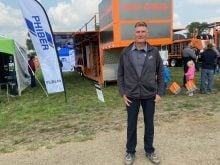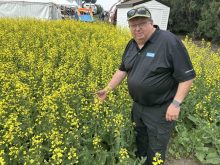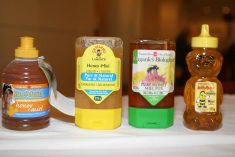A new product used in conjunction with some nitrogen fertilizers can reduce damage to seedlings and cut losses due to evaporation, according to research at the Agriculture Canada Brandon research centre.
The new product is an urease inhibitor called Agrotain.
Effective placement of nitrogen fertilizers can be a concern in low-disturbance farming. Urea and urea ammonium nitrate are economical and widely available sources of nitrogen but have two major drawbacks. They can be lost to evaporation if left on the soil surface, and they can produce seedling damage if concentrations near the seed are too high.
Read Also

VIDEO: New drone carrier wins ag tech innovation award
PhiBer’s trailer to land, recharge and refil four drones won the ag tech award at the innovation program for Ag in Motion 2025.
Such problems can be avoided by banding or incorporating urea-based fertilizers, but they increase soil disturbance.
Urea itself does not produce seedling damage and is not lost to the air. Rather, urea is converted to ammonia through the action of urease, an enzyme, found in soil and on crop residue. Ammonia produced near the surface can escape to the atmosphere as a gas, and high concentrations of ammonia in the seed row can damage germinating seedlings.
Urease inhibitors work by reducing activity of the urease enzyme, slowing its conversion to ammonia and keeping nitrogen in the urea form longer.
This lowers ammonia concentration at the application site, reducing the likelihood of losses by evaporation and seedling damage. Slowing the breakdown allows more time for rainfall, diffusion and leaching to move it away from the application site and dilute the concentration.
Since 1995, Brandon research centre scientists have conducted field and growth chamber experiments on promising urease inhibitors called n-(n-butyl) thiophosphoric triamide, or NBPT, now marketed in the United States as Agrotain.
Registration in Canada is pending. IMC-Agrico Company, the manufacturer of NBPT, said limited quantities of Agrotain will be available this spring in Western Canada.
Results from Brandon confirm Agrotain can reduce ammonia losses and seedling damage. While Agrotain consistently inhibits urease activity, it will not increase crop yield and nitrogen recovery under all circumstances.
Using Agrotain will be of most benefit where crop yield potential is high, soil nitrogen levels are low, and environmental conditions favor losses to the air. This would occur under warm conditions, on high pH soils and with heavy crop residues.
For producers who place urea-based fertilizers with seed, Agrotain is recommended only where seedling damage would be great enough to reduce crop yield, reduce its ability to compete with weeds or delay maturity. Seedling damage from seed-placed fertilizers is directly related to the concentration of ammonia in contact with the germinating seedlings.
Agrotain will not improve the performance of urea-based fertilizers every year. Ammonia losses and seedling damage are greatly influenced by environmental conditions.
Since it is difficult to predict weather changes far in advance, use of Agrotain can help producers reduce the risk of damage if conditions turn against them. Over the long term, this may significantly improve the economics of crop production.
When it works
- If nitrogen fertility is limiting crop yield when Agrotain is not applied.
- If enough applied fertilizer is lost by evaporation to affect crop yield.
- If fertilizer rates are high.
- If soils are high in pH.
- If there is little rainfall after seeding.
- If the percentage of the seedbed is low over which the seed and fertilizer is spread.
When it doesn’t work
- If soil has good texture with low pH.
- If soil has high nitrogen levels.
- If temperatures are cool.
- If yield potential is low.
















